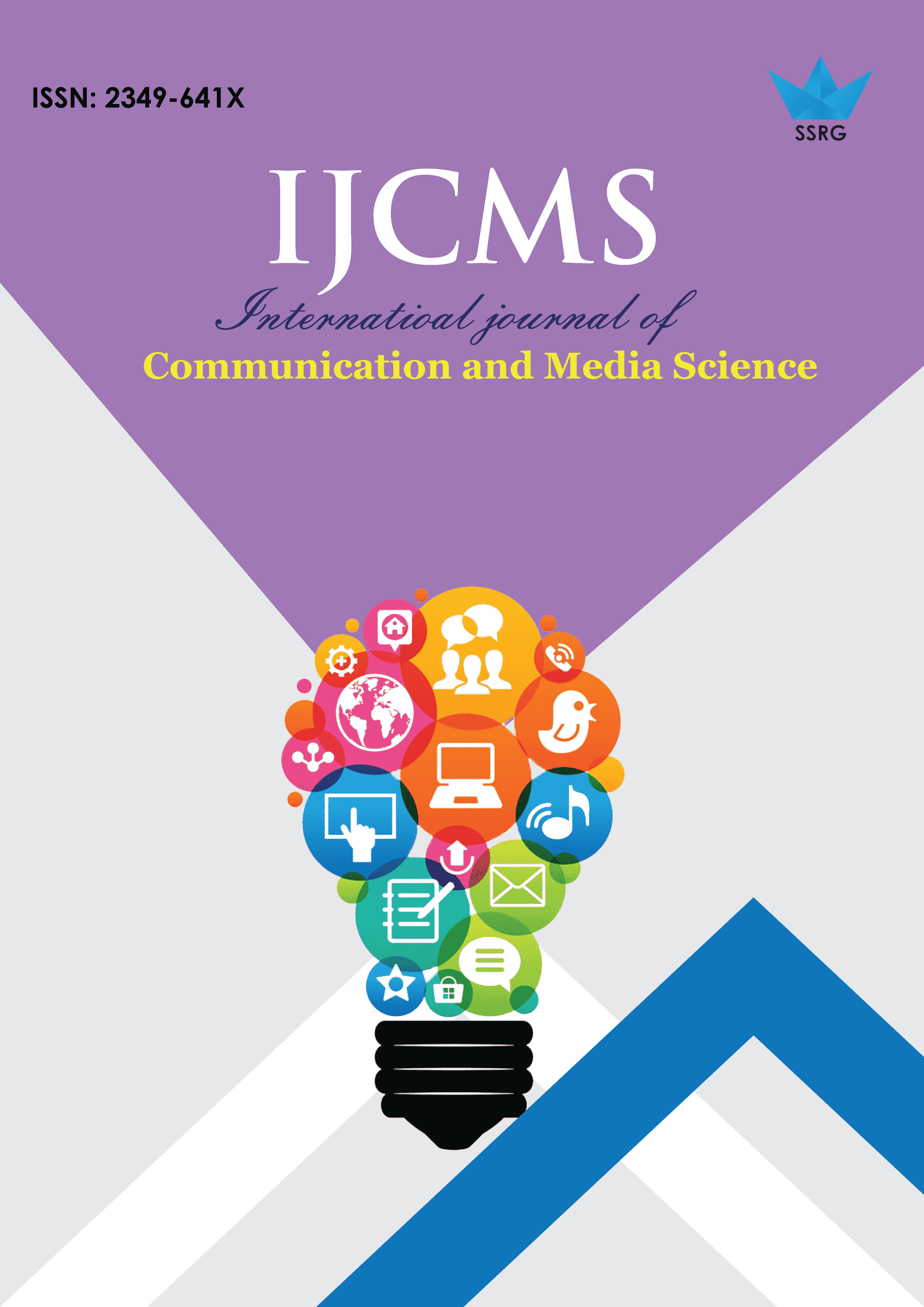The Fengshen Universe: Transmedia World-Building and Cultural IP of Fengshen Yanyi

| International Journal of Communication and Media Science |
| © 2025 by SSRG - IJCMS Journal |
| Volume 12 Issue 3 |
| Year of Publication : 2025 |
| Authors : Nguyen Thi Hang, Yang Huaiyuan, Ali Khan Shahryar, Nguyen Van Thang |
How to Cite?
Nguyen Thi Hang, Yang Huaiyuan, Ali Khan Shahryar, Nguyen Van Thang, "The Fengshen Universe: Transmedia World-Building and Cultural IP of Fengshen Yanyi," SSRG International Journal of Communication and Media Science, vol. 12, no. 3, pp. 1-8, 2025. Crossref, https://doi.org/10.14445/2349641X/IJCMS-V12I3P101
Abstract:
This study surveys the ongoing adaptation of Fengshen yanyi (Investiture of the Gods) in China's changing media ecology and offers the working concept of a “Fengshen Universe” to make sense of a new pattern of overlapping film, animation, and digital projects with cross-media engagement. Grounded on a literature review and a case-based exploration of some recent titles, it argues that two primary modes of adaptation have come to the fore, a blockbuster mode centered on a historical-fantasy world and a remake mode driven by the reproduction of key characters in animation; and that these two modes are influenced by three dynamic and mutually reinforcing forces, social changes, public taste, and new media. The study maps out what is carried over or redefined in the canonical cosmological framework, value system (agency, filiality, pedagogy), and plot configuration, and how publics are accommodated by selective re-emplotment. The role of transmedia strategies and fan engagement is highlighted in the extension of coverage and maintenance of public interest. The study also has implications for the industry as the adaptation of a popular classic into a shared universe could form a strong cultural IP, and that studios with transmedia planning and coordination are more likely to establish strong brand; but it is also found that in general, limited by worldbuilding, intertextual coordination, and lack of experience in IP governance, the story world of Fengshen has yet to reach its full potential. Based on these insights, this study proposes an interdisciplinary research agenda, including comparative media studies, reception studies across cultures, and industry-scholar collaboration for theoretical inquiries and practical designs to nourish a dynamic Fengshen Universe.
Keywords:
Fengshen yanyi (Investiture of the Gods), Transmedia storytelling, Chinese mythology, Cultural Intellectual Property (cultural-IP).
References:
[1] Tomas Atarama-Rojas, “Transmedia Storytelling and Construction of Fictional Worlds: Aliados Series as Case Study,” Correspondencias & Análisis, pp. 37–50, 2019.
[CrossRef] [Google Scholar] [Publisher Link]
[2] Nicoleta Popa Blanariu, and Dan Popa, A Mythological Approach to Transmedia Storytelling, 1st ed., The Routledge Companion to Transmedia Studies, pp. 1-8, 2018.
[CrossRef] [Google Scholar] [Publisher Link]
[3] Andrea V. Breen et al., “Movies, Books, and Identity: Exploring the Narrative Ecology of the Self,” Qualitative Psychology, vol. 4, no. 3, pp. 243–259, 2017.
[CrossRef] [Google Scholar] [Publisher Link]
[4] Ke Chen, and Seung-Woo Cho, “Modernizing Chinese mythological IP: A defamiliarization analysis of Nezha: The author am the destiny,” Asia-Pacific Journal of Convergent Research Interchange, vol. 10, no. 1, pp. 461–471, 2024.
[CrossRef] [Google Scholar] [Publisher Link]
[5] Shu Chen, Shuheng Chen, and Zhiling Zhang, “Nezha’s Multi Universe View: A Case Study of Coloroom,” Advances in Social Science, Education and Humanities Research, 2022.
[CrossRef] [Google Scholar] [Publisher Link]
[6] Xuguang Chen, “A ‘Creating God’ Experience of Chinese Film Industry and Aesthetics: Conversation with Wuershan, Director of Creation of the Gods the Author: Kingdom of Storms,” Journal of Chinese Film Studies, vol. 4, no. 1, 2024.
[CrossRef] [Google Scholar] [Publisher Link]
[7] Fan Jia-Yi et al., “Creating Cultural Brand Equity from the Perspective of Consumer Cognition: A Case Study of Chinese Animation Brands,” Procedia Computer Science, vol. 199, pp. 589–596, 2022.
[CrossRef] [Google Scholar] [Publisher Link]
[8] Filippo Gilardi, and Celia Lam, Transmedia in Asia and the Pacific, Palgrave Macmillan Singapore, 1st Edition, 2021.
[CrossRef] [Publisher Link]
[9] Neil Granitz, and Howard Forman, “Building Self-brand Connections: Exploring Brand Stories through a Transmedia Perspective,” Journal of Brand Management, vol. 22, pp. 38–59, 2015.
[CrossRef] [Google Scholar] [Publisher Link]
[10] Jie Gu, and Xijing Zhao, “From Telling a Story to Telling an Idea: A Transmedia Narrative of Amazing China Under New Propaganda Initiatives in China,” Transmedia in Asia and the Pacific, pp. 13–33, 2021.
[CrossRef] [Google Scholar] [Publisher Link]
[11] Donald Haase, The Greenwood Encyclopedia of Folktales and Fairy Tales, Greenwood Publishing Group, 2008.
[Publisher Link]
[12] Jenkins, H., 2007. Transmedia storytelling. Confessions of an Aca-Fan: The Official Weblog of Henry Jenkins. [Online]. Available: http://www.henryjenkins.org/2007/03/transmedia_storytelling_101.html
[13] Shelby Elizabeth Helen Judge, “Contemporary Feminist Adaptations of Greek Myth,” PhD Thesis, University of Glasgow, 2022.
[CrossRef] [Google Scholar] [Publisher Link]
[14] Zhichao Lei, “Tracing the Cultural Origin of Chinese Identity based on Ancient Chinese Myths: A Mythological Approach and Overview,” Asian Journal of Language, Literature and Culture Studies, vol. 7, no. 1, pp. 148–166, 2024.
[Google Scholar]
[15] Jiaqi Lv, “The Successful Exploration of the Value of Artistic Charm and Education—Taking the Movie “NE ZHA: I am the Destiny” as an Example,” Proceedings of the 2019 5th International Conference on Education, Management and Information Technology (ICEMIT 2019), 2019.
[CrossRef] [Google Scholar] [Publisher Link]
[16] Maciej Paprocki et al., “Divine Ontology and Multicultural Representation in the Marvel Cinematic Universe,” Thersites, vol. 20, pp. 130 190, 2025.
[CrossRef] [Google Scholar] [Publisher Link]
[17] Shin-Hee Park, “Trans Branding Strategy Methodology for Metaverse Ecosystem: Focusing on user Experience using Transmedia Storytelling,” Journal of Digital Contents Society, vol. 23, no. 10, pp. 2017–2025, 2022.
[CrossRef] [Google Scholar] [Publisher Link]
[18] Marie-Laure Ryan, “Transmedia Storytelling: Industry Buzzword or New Narrative Experience?,” Storyworlds: A Journal of Narrative Studies, vol. 7, no. 2, pp. 1–19, 2015.
[CrossRef] [Google Scholar] [Publisher Link]
[19] Melanie Schiller, “Transmedia Storytelling: New Practices and Audiences,” Stories, 2018.
[CrossRef] [Publisher Link]
[20] John D.H. Downing et al., “Media, Public Opinion, and Political Action,” The SAGE Handbook of Media Studies, 2004.
[CrossRef] [Publisher Link]
[21] Xuezheng Shen et al., “Devil or God: Image Transformation of Chinese Mythology Character “Nezha” (1927–2019),” Cartoon and Animation Studies, vol. 58, pp. 159–200, 2020.
[CrossRef] [Google Scholar] [Publisher Link]
[22] Hai Tang, Yang You, and Mengchun Ma, “A Reversed Construction Between Deities and Demons: A Case Study of Ne Zha: I’m the Destiny,” Journal of Educational Theory and Management, vol. 5, no. 1, 2021.
[CrossRef] [Google Scholar] [Publisher Link]
[23] Peter Von Stackelberg, and Ruth Eira Jones, “Tales of Our Tomorrows: Transmedia Storytelling and Communicating about the Future,” Journal of Futures Studies, vol. 18, no. 3, pp. 57–76, 2014.
[Google Scholar] [Publisher Link]
[24] Barbara Wall, “East Asian perspective in transmedia storytelling: Dynamic texts as hotbed for transmedia storytelling: A case study on the story universe of The Journey to the West,” International Journal of Communication, vol. 13, 2019.
[Google Scholar] [Publisher Link]
[25] Aiqing Wang, Thomas William Whyke, and Levi Dean, “The Interplay Between Digital Platforms and User-generated Content in Reinterpreting and Recreating Mythological Narratives with Traditional Chinese Cultural Elements: The Animated Series Yao–Chinese Folktales,” Creative Industries Journal, 2023.
[CrossRef] [Google Scholar] [Publisher Link]
[26] Wang Junzhe, and Xin Shuxian, “Research on the Development Trend and Evolution of the Chinese Animation Industry,” Journal of Humanities and Social Sciences Studies, 2024.
[CrossRef] [Google Scholar] [Publisher Link]
[27] Thomas William Whyke, and Joaquin Lopez Mugica, “Calling for a Hero: The Displacement of the Nezha Archetypal Image from Chinese Animated Film Nezha Naohai (1979) to New Gods: Nezha Reborn (2021),” Fudan Journal of the Humanities and Social Sciences, vol. 15, pp. 389–409, 2022.
[CrossRef] [Google Scholar] [Publisher Link]
[28] Thomas William Whyke, Joaquin Lopez Mugica, and Melissa Shani Brown, “Contemporizing the National Style in Chinese Animation: The Case of Nezha (2019),” Animation, vol. 16, no. 3, pp. 157-174, 2021.
[CrossRef] [Google Scholar] [Publisher Link]
[29] Thomas William Whyke, and Melissa Shani Brown, “Re-animating Chinese myths: Mythology and/as Mythologies in Contemporary Chinese Animation,” Chinese Film in the Twenty-First Century, 1st Edition, 2023.
[CrossRef] [Google Scholar] [Publisher Link]
[30] Jiewei Wu, Megat Ai Imran Yasin, and Chwee Fang Ng, “Integrating Social Cognitive Theory and Brand Equity Models: A Framework for Analyzing Audience Engagement Behavior in IP Animated Films,” International Journal of Academic Research in Business and Social Sciences, pp. 773-789, 2025.
[CrossRef] [Publisher Link]
[31] Jiewei Wu, Megat Ai Imran Yasin, and Chwee Fang Ng, “The Characteristics, Challenges, and Strategic Development of China IP Animated Films (2014–2024),” International Journal of Academic Research in Business and Social Sciences, pp. 638–655, 2025.
[CrossRef] [Publisher Link]
[32] Yimin Xu, “Review of New Gods: Yang Jian,” SFRA Review, vol. 53, no. 2, pp. 111–114, 2023.
[Google Scholar] [Publisher Link]
[33] Lihui Yang, Jessica Anderson Turner, and Deming An, Handbook of Chinese Mythology, Oxford University Press, 2008.
[Publisher Link]
[34] Sheng Ye, “A Study of Chinese Audience Preferences for Mythological Film and Television Works,” Cross-Cultural Design. Applications in Arts, Learning, Well-being, and Social Development, pp.95-106, 2021.
[CrossRef] [Google Scholar] [Publisher Link]
[35] Sijia Yu, “From Unconsciousness to Consciousness: Chinese Children’s Rights Awareness in the Evolution of Nezha’s Image,” Journal of Humanities, Arts and Social Science, vol. 7, no. 9, pp. 1704–1713, 2023.
[CrossRef] [Google Scholar] [Publisher Link]
[36] Dong Zhang, “Review of Research on Chinese Mythology,” Proceedings of the 8th International Conference on Education, Language, Art and Inter-cultural Communication (ICELAIC 2021), 2022.
[CrossRef] [Google Scholar] [Publisher Link]
[37] Pengxia Zhang et al., “The Audience’s Perspective: Decline of Mythical Elements in Films,” Sage Open, vol. 11, no. 3, 2021.
[CrossRef] [Google Scholar] [Publisher Link]
[38] Han Zhao, and Jasni Dolah, “Discussing the Narrative Elements of Retelling Traditional Myths in Chinese Animated Films: A Case Study of New Gods: Nezha Reborn (2021),” Herança, vol. 7, no. 4, pp. 222-235, 2024.
[CrossRef] [Google Scholar] [Publisher Link]
[39] Hanqing Zhao, “Analysis of the Characterization of Supporting Roles in Creation of the Gods the Author: Kingdom of Storms,” Arts Studies and Criticism, vol. 5, no. 5, 2024.
[CrossRef] [Publisher Link]
[40] Xinyu Zheng, Xiaoyan Zhang, and Xiaoci Jiang, “Innovative Research Based on Chinese Fantasy Film Narrative: Centered on the Integration of Film and Game,” Journal of Arts and Cultural Studies, vol. 3, no. 1, pp. 1–15, 2024.
[CrossRef] [Google Scholar] [Publisher Link]

 10.14445/2349641X/IJCMS-V12I3P101
10.14445/2349641X/IJCMS-V12I3P101